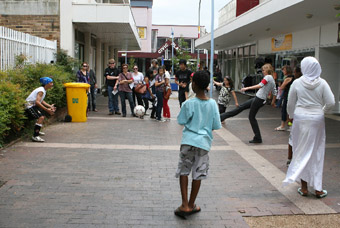mission just possible
david williams plays along with powerhouse youth theatre

City Quest
photo Chris Michaels
City Quest
THERE’S A WELL-ESTABLISHED BODY OF NEW MEDIA PERFORMANCE THAT DRAWS HEAVILY UPON COMPUTER GAME CULTURE, FROM THE UK GROUP BLAST THEORY’S SEMINAL DESERT RAIN AND CAN YOU SEE ME NOW? [SEE P26], TO THE MORE RECENT WAYFARER [RT81, P35] AT PERFORMANCE SPACE. IN EACH OF THESE WORKS, COMPUTER GAMES DICTATE THE DRAMATURGY AND PROVIDE THE NARRATIVE FRAMEWORK (A QUEST, A PURSUIT, A RACE). THE TRICK THAT MAKES BLAST THEORY’S WORK SO SUCCESSFUL IS THAT THE PERFORMANCES OPERATE IN BOTH DOMAINS, FUNCTIONING SATISFACTORILY AS GAMES BUT ALSO AS LIVE PERFORMANCE, INTERROGATING AND INTERVENING INTO BOTH THE CONDITION OF GAMING AND OF LIVENESS.
It’s clear from the outset that Powerhouse Youth Theatre’s City Quest has some big shoes to fill. City Quest is an ambitious undertaking, a feature of artistic director Claudia Chidiac’s work with Powerhouse since her appointment in 2005. That work includes the intelligently provocative This Territory (2007, in collaboration with Australian Theatre for Young People) and the cross-cultural wedding spectacular I do… but (2006).
For a weekend, PYT occupied several city blocks at the centre of Fairfield, inserting performers, video installations and other interventions amidst the shops and public spaces of this suburban centre. The safety briefing at the outset declares, “all the people are real”, further noting that if audience members “see something you like please feel free to purchase.” So while the gaming rhetoric poses a crisis that must be averted, the frame of the performance places a surprising emphasis on tourism.
It’s an unusual positioning of the audience. On the one hand, the ‘missions’ to address the civic crisis that the game proposes (the ‘Emerald Torch’ that somehow maintains social stability has been lost and must urgently be recovered) frame the audience as the potential saviours of Fairfield. On the other hand, the nature of these missions are to look closely at the inhabitants of this urban landscape, performer and resident alike, and to examine the nooks and crannies of this section of western Sydney suburbia, cameras in hand. And of course, along the way, we’re encouraged to engage in commerce. “You are in Fairfield, try something you can’t pronounce.” The audience as tourist cum civic saviour? Over lunch in a Turkish restaurant, two young locals inform me that the show “has really put Fairfield on the map” by bringing all these inner city types out of their geographic comfort zone. City Quest thus produces a fascinating convergence of art, gaming and social life.
We’re ushered in to meet the computer-generated gamemaster, The Watcher, who sets the scene: play out your missions, look for clues and ultimately uncover the location of the Torch. Assigned a mission, I dutifully carry my digital camera onto the streets and take pictures of details as instructed—flags, something emerald, someone in mid-air, and something I can’t pronounce. Along the way, I interact with a variety of young performers, some in installations on the streets. Some encounters are more peripatetic. Each of the performers has a story to tell, as well as clues to offer, provided that I perform whatever task or undergo whatever small ritual humiliation they request—submitting to a fashion makeover, shooting goals in an alleyway, recovering an ‘alien’ artefact. I accumulate multicoloured tokens for my labours, a tally of which at the end will constitute my final ‘score.’ Despite The Watcher’s urgency, on the streets everything is pretty relaxed, with plenty of surplus time to window shop and chat with other audience members, sharing clues gathered so far.
We’re led to a carpark rooftop where a piratical Vagabond announces that The Watcher cannot entirely be trusted, that his control of our questing should be contested. A choreographed battle ensues, with rival characters vying for control of a ‘key’ by leaping thrillingly from one level of the carpark to another. This results in more clues that lead to a code concealed in a laneway, a phone number whose message in turn sends us back to mission control.
As a game, City Quest isn’t entirely coherent or compelling, but as a social and cultural experience, it’s engaging, entertaining and generally a fantastic day out. Without really having to do anything besides turning up and playing along, order and hope is returned to the city of Fairfield. And the Emerald Torch? Well, that was back at the beginning, and I touch it as I exit, granted hopeful glimpses of the future both for the city and the characters who’ve populated it.
Powerhouse Youth Theatre, City Quest, director Claudia Chidiac, deviser-performers Jhon Al Asadi, Ricardo Ciccone, Geneveive Clay, Khoa Doun, Will Erimya, Collin Gosper, Nour Issawi, Ali Kadhim, Andy Ko, Anna Nguyen, Htoora Thahiya, Evin Tobia, game design, composition Keith Lim, sound, multimedia Khaled Sabsabi, design Kate Shanahan, Le Parkour choreography Ali Kadhim, premium fighter Craig Anderson, animation Michael Zhu, multimedia & software consultant, production manager Simon Wise,video maker Fatima Mawas, Ryan Peters; Fairfield, Sydney, Dec 8-9, 2007
RealTime issue #83 Feb-March 2008 pg. 36






